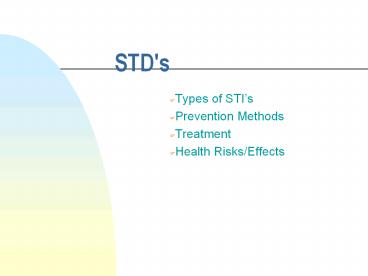STD's - PowerPoint PPT Presentation
1 / 15
Title: STD's
1
STD's
- Types of STIs
- Prevention Methods
- Treatment
- Health Risks/Effects
2
Types
- Viral
- Bacteria
- Protozoa
- Parasites
- Fungi
3
Types of Viral STIs
- HPV/Genital Warts
- Genital Herpes
- Advanced HIV disease/AIDS
- Hepatitis
4
HPV/Human Papaloma Virus/Genital Warts
- Skin to Skin
- Symptoms occurs 1 -6 months after exposure
- Small, bumpy warts on and around genitals
- Itching burning around sex organs
- Precursor to cervical cancer in women.
- No cure No Vaccine
- Highly contagious
5
Genital Herpes
- Symptoms begin 2 - 30 days after infection.
- Small painful blisters on sex organ, mouth and
anus. - Blisters can last 1 - 3 weeks.
- Blistering can reoccur
- Contagious while blisters are active!
- No cure - No Vaccine
- Flu-like feeling/fever
6
Advanced HIV Disease
- Several months to several years up to 15. Tests
can convey a false negative for up to 6 months. - Attack t -cells, which allow the body to
recognize other infections. - People eventually die from it.
- No cure - No vaccine!
- ELISA blood test.
- Patients die of opportunistic diseases.
7
Hepatitis
- Inflammation to the liver.
- Can be spread by intimate contact such as
kissing, sharing toothbrush, razors, washcloths,
or drug needles. - Yellow skin, nausea, fever and abdominal.
- Can be contagious even after signs disappear.
- Exchange of body fluids
- Vaccine is available.
8
Viral STIs
- Once infected always infected
- A vaccine is available for Hepatitis B only,
others are possible, but genetic mutation
complicates this treatment. - They attack host cells so they can replicate
themselves, then attack more health cells. - Cannot live on their own
- Immune system produces antibodies, but immune
system cannot always prevent an outbreak. - Cannot be treated with Antibiotics
9
Types of Bacteria
- Syphilis
- Gonorrhea
- Chlamydia
- Produce toxins and enzymes that damage human
cells. - Most are controllable with antibiotics
- Neglected, can cause sterility, major organ
deterioration, and death.
10
Syphilis
- Less common, most deadly of the bacteria.
- Primary stage-symptom is a chancre a painless
sore on the infected part. Treatable/Contagious - 2nd Stage 2 wk. to 6 months-rash can last for up
to 6 months. Without treatment it will go away.
Treatable/Contagious - Latent Stage-1 to forty years attack major
organs. Permanent damage occurs.
Treatable/Contagious - Late stage-health problems like heart
damage,blindness, paralysis mental disorders and
death. Untreatable, no longer contagious.
11
Gonorrhea
- Bacterial infection that attacks the urethra in
men and the internal reproductive organs of the
female. - 1-14 days after infection-painful,burning
urination. - Both males and females will have a
discharge-yellow green discharge from the penis
females discharge from the vagina. - If untreated it will cause permanent damage to
reproductive organs - causing sterility.
12
Chlamydia
- The most common STI.
- Bacterial
- inflammation of the urethra is called NGU.
- It is the leading cause of non-voluntary
sterility - Symptoms appear 1-2wks. After exposure.
- Symptoms include painful urination in males
females vaginal discharge, pelvic pain, bleeding,
fever, nausea.
13
Yeast - Protozoa - Parasite
- Yeast - imbalance in the healthy bacteria of the
vagina. - Protozoa / Trichomonas Single cell, animal like
organism. - Pubic Louse/Crabs and Scabies Tiny insect and
mites that live as external parasites on the body.
14
Scabies/Crabs-Pubic Lice
15
Transmission/Effect/Symptoms/Treatment
- Skin to Skin contact Shared linens sexual
intercourse with an infected person - oral, anal,
and vaginal exchange of body fluids - Release enzymes and toxins that destroy human
cells or feed off human blood - Symptoms - itching, discharge, odor, painful
urination, pelvic pain, fatigue, fever, and skin
conditions. - Treatment - special antibiotics from a doctor
and/or - over the counter medication.
- Prevention Strategies - education, abstinence,
communication with partner, early detection, and
complete medical care.

